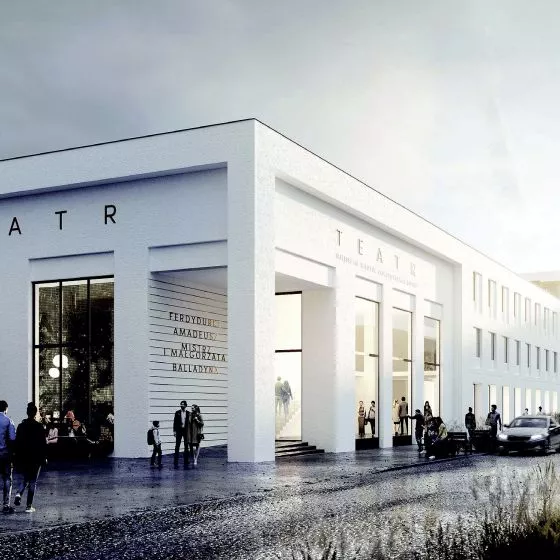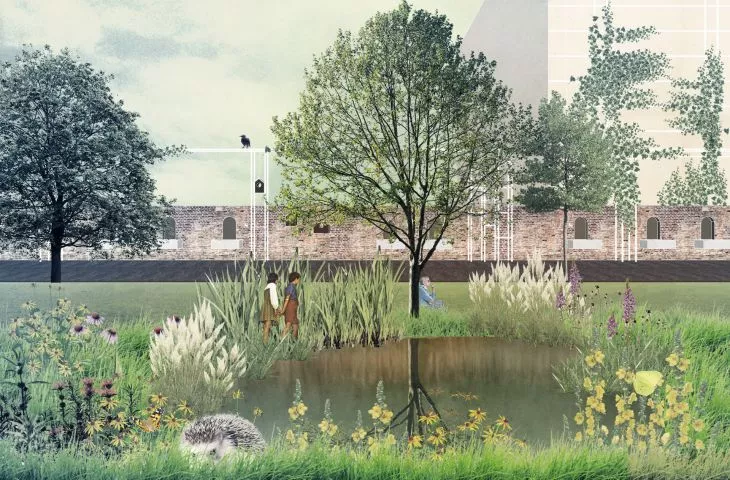Less than a year ago, in the series City on Purpose, Katarzyna Jagodzinska looked at the fate of the park on Karmelicka Street in Krakow, which won last year's edition of the civic budget. Located in the city center, the area of the roll-call square of the former military barracks is now occupied by a parking lot. After much wrangling and action by city activists, a plan for the area was passed in 2018, according to which ninety-four percent of the plot is to be used for greenery, and the remaining six for park infrastructure development. Along the way, there were ideas of creating an underground parking lot with a rooftop park at the site, and even reserving the plot for a subway study.
Tender instead of competition
In the end, thanks to funds from the civic budget, a park named after Wislawa Szymborska will be built right next to the Provincial Public Library building and the Malopolska Art Garden. What will it look like? Although the location of the plot is extremely prestigious, there was no competition for its development, but a tender for the development of design and cost documentation. You can read more about it in Katarzyna Jagodzinska's article "To design Krakow by tender". On September 19 the winner of the tender for the design of the park at Karmelicka Street was announced - the company Gajda Architektura Krajobrazu, whose credits include the revaluation of Park Krakowski and Park Jordana. Work is scheduled to begin in 2022.
Concept by designers
from the miastopracownia and JAZ+ offices
A team of designers from miastopracownia and JAZ+ office also prepared their proposal for the development of the Nobel Prize winner's park, inspired by the poet's sensitivity and her attitude to the natural world.
Our goal was to create a peaceful park, functioning all year round, where nature and culture will intermingle. A park that can be implemented in stages and that takes into account the various limitations of the users' abilities (not only motor skills). Conceived not only for human residents of the city of Krakow, but also for birds, small mammals or insects," write the authors of the project.
The drawerland is made up of walls-installations on an openwork structure housing, among other things, hotels for insects and shelves for plants
© Miastopracownia, JAZ+ Architekci
Some of the spatial solutions refer to both the person and works of Wislawa Szymborska - around the borders of the park the architects designed a drawerland - a place inspired by "Szymborska's Drawer," which is formed by walls-installations on a white openwork structure housing, among other things, hotels for insects, shelves for plants in pots, or a closet for exchanging books. As the authors of the concept add, the drawerland is also a space for artistic acupuncture and searching for hidden "treasures." Another element reminiscent of the park's patroness is a neon sign mounted on the green wall with the title of Szymborska's poem dedicated to nature - "Jarmark Cudów".
neon sign "Jarmark Cudów"
© Miastopracownia, JAZ+ Architekci
The park - an oasis in the middle of the city - is intended to be a natural, year-round place conducive to relaxation and reading. The designers have also included space for picnics, computer work, the organization of a summer cinema or an autumn poetry reading, during which viewers and listeners will be able to sit on seats amphitheatrically inscribed in the landscape. What's more, the choice of materials, models of small architecture, audiodescription, or leveling of terrain differences is adapted to the needs of residents of different ages and fitness levels.
The designers have also provided for the park's area: diverse greenery - tall trees, shrubs, a flower meadow, a butterfly meadow and a clearing of herbs, water - a stream and a pond, as well as drinking water intakes for humans and animals, and bird and insect houses, nesting boxes and drinkers.
site development plan
© Miastopracownia, JAZ+ Architects
An important element of the project, the authors stress, is the introduction of water and water retention solutions and the selection of species in such a way that the park can both use and retain rainwater. According to the concept, rainwater would be collected from the roofs of neighboring townhouses, the new building serving the park and the roof of the adjacent library. First, the collected water would be directed to the clusters of hydrophytic plants, and then, using the natural terrain, would be guided by a dry stream along the park paths to the newly designed pond on the side of Dolne Młyny Street.
Water in the park on Karmelicka Street is run on the surface, because its presence has not only ecological or aesthetic value, but also a social dimension. Christopher Alexander, in his book "The Language of Patterns," emphasizes the importance of the need for a close relationship between the human body and water, and therefore the design and introduction of surface water in places where we are supposed to rest, interact with other people and gain strength, the authors of the concept add.




























